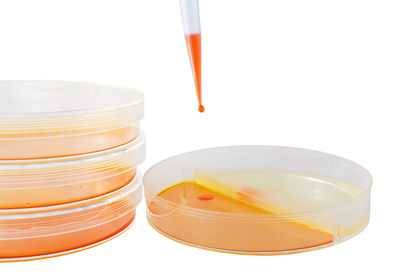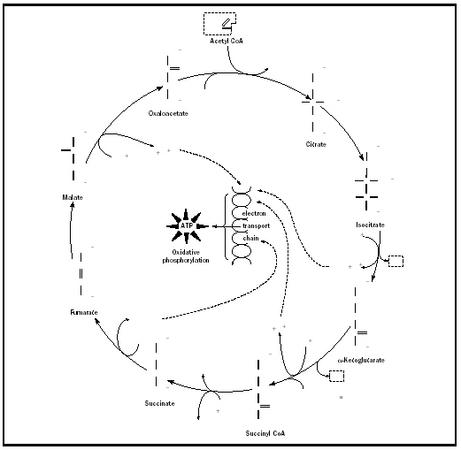Krebs Cycle

The Krebs cycle is a series of enzymatic reactions that catalyzes the aerobic metabolism of fuel molecules to carbon dioxide and water, thereby generating energy for the production of adenosine triphosphate (ATP) molecules. The Krebs cycle is so named because much of its elucidation was the work of the British biochemist Hans Krebs. Many types of fuel molecules can be drawn into and utilized by the cycle, including acetyl coenzyme A (acetyl CoA), derived from glycolysis or fatty acid oxidation . Some amino acids are metabolized via the enzymatic reactions of the Krebs cycle. In eukaryotic cells , all but one of the enzymes catalyzing the reactions of the Krebs cycle are found in the mitochondrial matrixes.
The sequence of events known as the Krebs cycle is indeed a cycle; oxaloacetate is both the first reactant and the final product of the metabolic pathway (creating a loop). Because the Krebs cycle is responsible for the ultimate oxidation of metabolic intermediates produced during the metabolism of fats, proteins, and carbohydrates, it is the central mechanism for metabolism in the cell. In the first reaction of the cycle, acetyl CoA condenses with oxaloacetate to form citric acid. Acetyl CoA utilized in this way by the cycle has been produced either via the oxidation of fatty acids, the breakdown of certain amino acids, or the oxidative decarboxylation of pyruvate (a product of glycolysis). The citric acid produced by the condensation of acetyl CoA and oxaloacetate is a tri carboxylic acid containing three carboxylate groups. (Hence, the Krebs cycle is also referred to as the citric acid cycle or tricarboxylic acid cycle.)
After citrate has been formed, the cycle machinery continues through seven distinct enzyme-catalyzed reactions that produce, in order, isocitrate, α -ketoglutarate, succinyl coenzyme A, succinate, fumarate, malate, and

oxaloacetate. The freshly produced oxaloacetate, in turn, reacts with yet another molecule of acetyl CoA, and the cycle begins again. Each turn of the Krebs cycle produces two molecules of carbon dioxide, one guanosine triphosphate molecule (GTP), and enough electrons to generate three molecules of NADH and one molecule of FADH 2 .
The Krebs cycle is present in virtually all eukaryotic cells that contain mitochondria, but functions only as part of aerobic metabolism (when oxygen is available). This oxygen requirement is owing to the close relationship between the mitochondrial electron transport chain and the Krebs cycle. In the Krebs cycle, four oxidation–reduction reactions occur. A high energy phosphate bond in the form of GTP is also generated. (This high energy phosphate bond is later transferred to adenosine diphosphate [ADP] to form adenosine triphosphate [ATP].) As the enzymes of the Krebs cycle oxidize fuel molecules to carbon dioxide, the coenzymes NAD + , FAD, and coenzyme Q (also known as ubiquinone) are reduced. In order for the cycle to continue, these reduced coenzymes must become reoxidized by transferring their electrons to oxygen, thus producing water. Therefore, the final acceptor of the electrons produced by the oxidation of fuel molecules as part of the Krebs cycle is oxygen. In the absence of oxygen, the Krebs cycle is inhibited.
The citric acid cycle is an amphibolic pathway, meaning that it can be used for both the synthesis and degradation of biomolecules. Besides acetyl CoA (generated from glucose , fatty acids, or ketogenic amino acids), other biomolecules are metabolized by the cycle. Several amino acids are degraded to become what are intermediates of the cycle. Likewise, odd-chain fatty acids are metabolized to form succinyl coenzyme A, another intermediate of the cycle. Krebs cycle intermediates are also used by many organisms for the synthesis of other important biomolecules. Some organisms use the Krebs cycle intermediates α -ketoglutarate and oxaloacetate in the synthesis of several amino acids. Succinyl coenzyme A is utilized in the synthesis of porphyrin rings, used in heme manufacture and chlorophyll biosynthesis . Oxaloacetate and malate are utilized in the synthesis of glucose, in a process known as gluconeogenesis.
SEE ALSO Glycolysis ; Krebs, Hans Adolf .
Robert Noiva
Bibliography
Berg, Jeremy M.; Tymoczko, John L.; and Stryer, Lubert (2002). Biochemistry, 5th edition. New York: W. H. Freeman.
Voet, Donald; Voet, Judith G.; and Pratt, Charlotte W. (2002). Fundamentals of Biochemistry, updated edition. New York: Wiley.
Comment about this article, ask questions, or add new information about this topic: